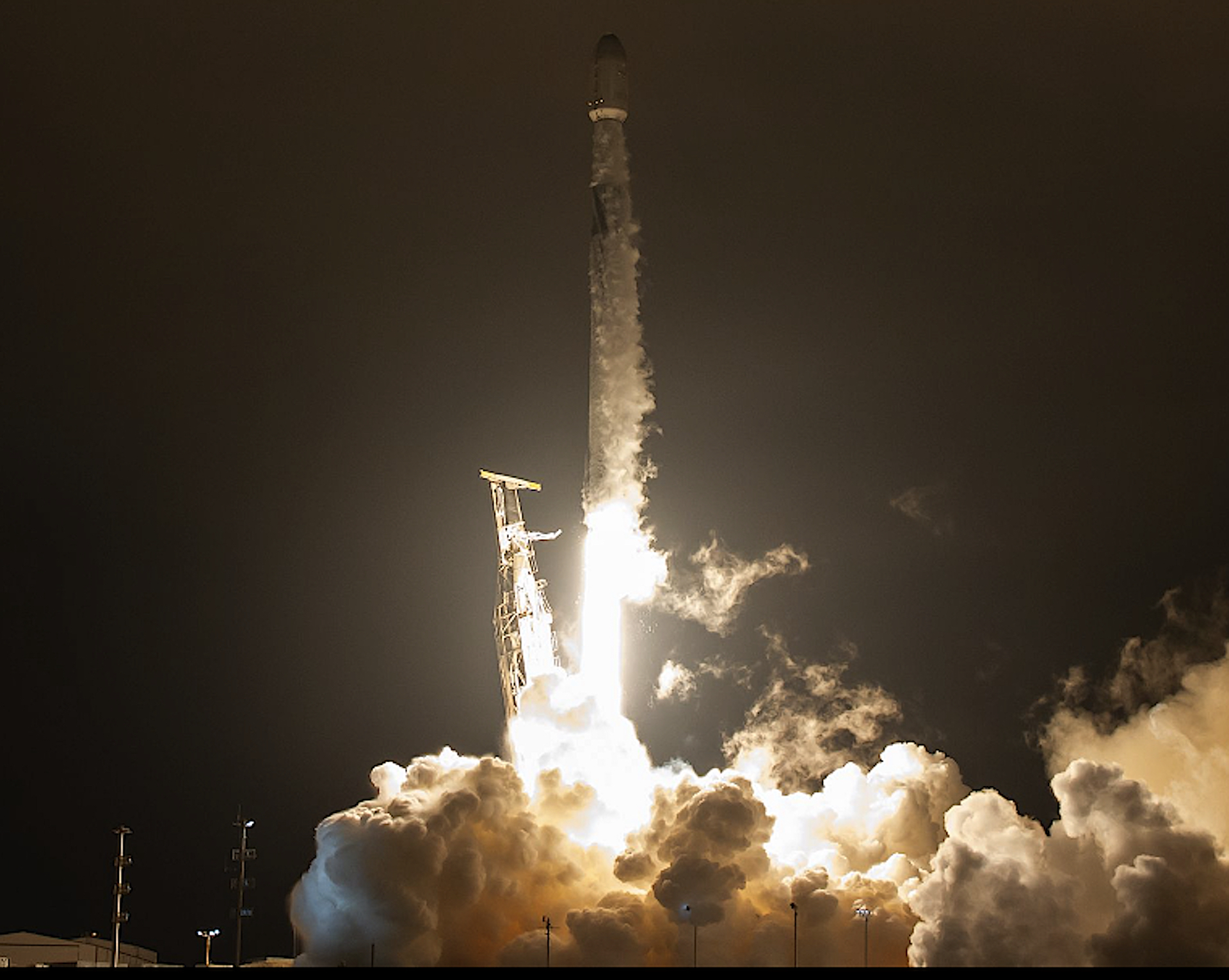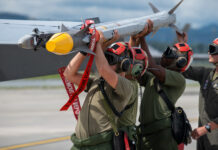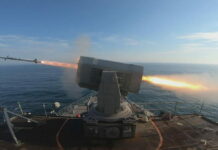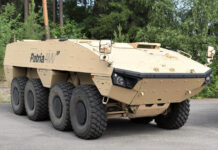Amid an uncertain security environment, competition in Low Earth Orbit and the stratosphere is heating up.
SpaceX launched their 42nd Starlink delivery mission of the year on 25 September 2023, at 4:48 a.m. EDT, when a Falcon 9 rocket successfully launched from Vandenberg Space Force Base in California. The rocket placed 21 V2 Mini Starlink satellites into LEO as part of SpaceX’s Starlink communications constellation. The V2 is a second-generation Starlink mini-satellite that according to SpaceX offers four times more capacity per satellite than earlier Starlink models. This is thanks to the V2’s improved phased array antennas, E-band backhaul and a laser communications system. LEO satellite networks are a key infrastructure requirement for the next wave of global high-speed internet coverage. This next generation technology, 6G, will better connect units in the battlespace. Along with 5G internet, 6G is the lifeblood of Joint All-Domain Command and Control and will enable virtual and augmented reality, high-definition video surveillance, and artificial intelligence (AI).
On the other side of the globe, the Chinese People’s Liberation Army (PLA) view the launch of the newest SpaceX satellites as a threat. A PLA assessment from April 2022 called for the creation of strategies to monitor, disable, and destroy the Starlink satellite constellation in the event of war with the US. This 2022 PLA report, listed on China Military Online, 12 May 2022, reads: “Orbital position and frequency are rare strategic resources in space. At present, the geosynchronous orbit has almost been fully occupied and the scramble for Low Earth Orbit and Medium Earth Orbit positions has become more intense. The LEO [layer] is able to accommodate about 50,000 satellites, over 80% of which would be taken by Starlink if the program were to launch 42,000 satellites as it has planned. SpaceX is undertaking an enclosure movement in space to take a vantage position and monopolize strategic resources.”
China is examining how Starlink is used in the war in Ukraine. When Russian forces invaded Ukraine on 24 February 2022, one of their goals was to disrupt and dominate Ukraine’s digital infrastructure. Russian leadership views control of information as a key component in establishing control over a country or population. However, today’s media includes the Internet, social media services such as Telegram, Reddit, X (formerly Twitter), Instagram, and Tik-Tok, as well as instant messaging. As a precursor to their ground invasion of Ukraine, on 15 February 2022, the Russians executed extensive cyberattacks on Ukraine’s internet and ViaSat’s satellite network. These included continual Distributed Denial of Service (DDoS) attacks culminating on the day of the invasion, when Ukraine’s primary internet service provider, Triolan, was taken down by Russian DDoS offensive actions.
These DDoS attacks caused internet outages across large swathes of the country and left thousands of Ukrainians without communications. This also left Ukrainian citizens in the dark about the Russian invasion, creating fear and uncertainty.

Credit: SpaceX
Russia has also carried out kinetic, electronic warfare (EW), and cyber-attacks on Ukraine’s internet infrastructure. This denial of communications not only denigrated the ability of the Ukrainians to mount an organised resistance, it also fanned the flames of panic. Despite their initial success, the Russians did not achieve their strategic goal of eliminating Ukraine’s internet. A key contributing factor for this resilience was the rapid deployment of Starlink to Ukraine.
What is Starlink?
Several countries and private companies are currently involved in deploying LEO broadband super-constellations, such as SpaceX’s Starlink, OneWeb, Amazon’s Project Kuiper, and Telesat’s Lightspeed. These constellations aim to provide global internet coverage by deploying hundreds (as in the case of OneWeb) to thousands (as with Starlink) of satellites in LEO. Of all these companies, SpaceX has deployed the largest satellite constellation in orbit today. It provides broadband internet access to enable voice and data communications anywhere in the world. A constellation of thousands of satellites in LEO, circling the earth at a distance of about 550 km (342 miles), beams the signal from space to terrestrial Starlink receivers. Most single geostationary satellites orbit Earth at about 35,000 km (21,750 miles). Since Starlink satellites are much closer to ground-based stations, the data transmission time is faster, and this generates high-speed data transmission for earthbound devices. All that is needed to access Starlink is a receiver and a subscription. It also works while on the move, an important consideration for military use.
SpaceX launched the first micro-satellites in February 2018. These satellites are small compared to the size of most telecommunication satellites—3.2 m × 1.6 m × 0.2 m
in size and weigh about 227 kg. Each satellite has a solar-panel array to generate power for the on-board computer and electronics. Four phased-array antennas and two parabolic antennas transmit and receive data. A unique ion-propulsion system fuelled by Krypton, the first ion–krypton drive to enter service on spacecraft, provides propulsion for manoeuvre and deorbit. Starlink satellites have a built-in, autonomous collision-avoidance system that automatically manoeuvres the satellite to avoid hitting other objects in space.
The on-board navigation system scans the stars to ensure orientation, altitude, and location to provide the optimum signal to ground receivers. To improve communications security and speed up data transmission, a laser-based optical intersatellite link system was added to every Starlink satellite launched after 24 January 2021, allowing the satellites to relay data to one another without local ground stations. Starlink provides broadband internet service to over 32 countries and has over 1.5 million subscribers worldwide. In short, Starlink is a successful LEO satellite communications network that enables reliable, high-speed and secure communications around the world.
Lessons from Ukraine
The military applications of Starlink are tremendous. In the ongoing Russia–Ukraine War, SpaceX donated 3,667 Starlink terminals to Ukraine, and the US Agency for International Development (USAID) purchased a further 1,333 terminals. The Ukrainians reformed their communications networks and learned they could use the Starlink for more than just voice and data transmissions, but also to communicate with some types of drones. In the early days of the war, the Ukrainians employed many types of drones, including small unmanned aerial vehicles (UAVs), medium altitude long endurance (MALE) armed UAVs, and loitering munitions (LMs), to find and strike Russian command posts, artillery, and other high-value targets. As the fighting has worn on, the Russians adapted, using their EW systems to jam Ukrainian drone signals. To disrupt drone operations, especially those involving small UAVs, many counter-unmanned aerial vehicle (C-UAV) weapons focus on jamming line-of-sight signals from terrestrial controllers, thereby causing the drone to either land or return to its point of origin.
Ukrainian operators adapted to Russian jamming by improvising. The Aerorozvidka NGO, functioning as the Ukrainian Army’s drone specialist unit founded by volunteer internet and drone specialists, adapted Starlink to control their drones. “We use Starlink equipment and connect the drone team with our artillery team,” said Yaroslav Honchar, an Aerorozvidka commander in an interview in the 18 March 2022, edition of The Times. “If we use a drone with thermal vision at night, the drone must connect through Starlink to the artillery guy and create target acquisition.” As unmanned warfare increases in scale, tactical employment, and capabilities, satellite communications systems such as Starlink will be an indispensable element in modern warfare. Brandon Wall and Nicholas Ayrton, in an article in the US Centre for International Maritime Security (CIMSEC) published in September 2021, hypothesised, “A small fleet of semi-autonomous drones could also act as a screening force for operations, acting to provide an extended sensor net and provide greater tactical awareness, be they for combat operations or as an early warning system.”
Starlink is not a ’silver-bullet’ battle communications solution, but has proven to be extremely resilient in combat despite Russia’s best efforts to use their cyber and EW capabilities to defeat it. As the fighting continues in Ukraine, other nations are taking notice of Starlink’s effectiveness as a wartime means of communication. According to Business Insider, in an article by Ren Yuanzhen in Modern Defence Technology magazine, published in China, the PLA is studying ways to counter Starlink. The PLA understands Starlink’s potential and considers it a major threat. “It is recommended to apply a combination of soft and hard killing methods to disable some Starlink satellites and destroy their operating systems.” The Russians concur with the PLA’s assessment. Dmitry Litovkin, editor-in-chief of the Independent Military Review, as quoted on Radio Sputnik on 9 May 2022, stated, “The Starlink constellation of 2,000 satellites has performed well in Ukraine. China sees it as a threat to its security. It is capable of transmitting data from aircraft and drones a hundred times faster. Therefore, in Beijing, they want to create a system that would be able to track and destroy satellites.”

Credit: SpaceX
Li Xiaoli, a Chinese military analyst, made the following argument in a May 2022 essay that appeared in China Military Online: “When completed, Starlink satellites can be mounted with reconnaissance, navigation and meteorological devices to further enhance the US military’s combat capability in such areas as reconnaissance, remote sensing, communications relay, navigation and positioning, attack and collision, and space sheltering. Clearly, the military applications of the Starlink programme will give the US military a head-start on the future battlefield and become an ‘accomplice’ for the US to continue to dominate the space.”
While China is working to put satellites in orbit, neither they, nor the Russians, have their own Starlink-like constellations. As of late-October 2023, SpaceX has 4,938 Starlink satellites in orbit, with more to be launched in the coming months.
Going beyond Starlink, in December 2022 SpaceX presented Starshield, a version of Starlink for the US military, intended to provide a secure satellite network for the US government and the military with high-assurance cryptographic capability. The Starshield programme will prioritise three key areas: earth observation, communications, and hosted payloads. The programme aims to launch satellites equipped with sensors to gather data and deliver it directly to users. It also aims to offer secure global communications and laser communications links to connect non-Starlink satellites into the Starlink network.
Guowang – China’s Own Starlink
In terms of numbers of satellite launches, China is second only in the world to the US. According to Statista, a German online platform that focuses on data collection, China has 562 navigation and observation satellites operating in space. However, China has few communication satellites in LEO. In order to compete with Starlink and other Western efforts, China revealed in early 2023 that it planned to launch a 12,992-satellite LEO broadband constellation known as ’Guowang.’ These satellites will serve as the foundation for China’s own national satellite internet network, similar to the Starlink and OneWeb constellations, according to a professor at the People’s Liberation Army Space Engineering University quoted by the South China Morning Press. The report also suggested that “anti-Starlink” payloads could be installed on GW constellation satellites. China also considers the Guowang network as an enabler for the PLA and China’s Belt and Road initiative.
On 9 July 2023, China launched its first prototype of the GW network. The project is now a major effort of China’s State-Owned Assets Supervision and Administration Commission (SASAC), which oversees China’s largest state-owned enterprises and is led by Chinese company SatNet. According to filings issued to the International Telecommunication Union (ITU), the company intends to create two constellations (GW-A59 and GW-2) with a coverage of 37.5 to 42.5 GHz (space-to-Earth communications) and 47.2 to 51.4 GHz (Earth-to-space communications). On 9 July 2023, a Long March 2C rocket carried a prototype satellite into LEO to conduct testing of its broadband capabilities. More launches are planned to follow once this testing is completed.
The Stratosphere – An Alternative to LEO
Another means to provide surveillance, navigation, observation, and telecommunications short of launching satellites into LEO or farther into space is to create a network of high altitude platforms in the stratosphere. The stratosphere is that area of the Earth’s atmosphere, which starts at roughly 14.5 km to about 50 km above the Earth’s surface. The stratosphere is relatively stable and free from clouds as it lies above the Earth’s weather systems. Only very specialised military aircraft, such as the US U-2, can operate in the stratosphere. This also means that either long-range ground-based air defence systems or relatively high-altitude-capable aircraft are needed to shoot down balloons operating at this altitude. Due to these unique operating conditions, the military applications of platforms in the stratosphere are of particular interest.
Balloons are the most mature platform for carrying heavy payloads to high altitudes for persistent communications and intelligence, surveillance, and reconnaissance (ISR) missions, even though some special aircraft and UAVs can operate in the stratosphere. Balloons manoeuvre by changing altitudes to various wind layers to stay in an operating area. Solar-powered UAVs are optimised for electric powered propeller propulsion in the thin atmosphere of the stratosphere. They are more manoeuvrable than balloons, however, they typically have a significantly lower payload capacity. By contrast, even though balloons are slow to manoeuvre, are the best way to carry heavy sensors to high altitudes for long periods of time. As such, combining balloon and UAV operations may be the best way to optimise persistent ISR at high altitudes.

Credit: US DoD
The latest lighter-than-air (LTA) systems can carry large and sophisticated ISR and communications packages to provide persistent surveillance, network connectivity, and EW support over terrain obstructions. Military LTA craft, often known as aerostats, can operate in the stratosphere to provide radar-based surveillance for air defence. Aerostats can be tethered or free flying, and can operate higher than most aircraft, but below satellites, from between 18-30 km above the ground, and can remain over an area of operations for long periods of time.
One leading defence firm involved in military aerostats is the American defence corporation Lockheed Martin. The company was involved in military balloons with the US Navy before World War II and its latest, high-tech models are not your grandfather’s blimp. The US used tethered tactical aerostats, at lower altitudes, for surveillance along the southern US border to combat drug trafficking. Since 2013, the Lockheed Martin 420K Aerostat System, with a length of 64 m and payload capacity of 1,000 kg, was the only ISR and communications balloon in daily use in the US until the Biden administration cut funding for the programme in 2021, resulting in eight of the fleet of 12 being grounded by early 2023. Another Lockheed Martin tactical aerostat model, designed for military persistent surveillance and communications at lower altitudes, is the Lockheed Martin 74K Aerostat. The craft is 35 m long and is tethered with a fibre-optic transmission cable. It can carry a payload of 500 kg.
Higher-flying airships can provide significant wide-area surveillance and communications advantages for urban combat operations. Lockheed Martin’s High-Altitude Airship (HAA) can operate in the stratosphere and provides the ability for unmanned, persistent, geostationary ISR, electronic warfare, and communications. No tether is required as the HAA can manoeuvre in the airspace as directed from a ground station or satellite relay.
Typical payloads for this type of aerostats would include surveillance radars, inertial and/or satellite navigation system, optronic sights, electronic-intelligence systems, and communications intelligence packages. Going beyond sensors and communications, in future armed aerostats could serve as weapons platforms able to conduct precision strikes.
On 28 January 2023, a Chinese intelligence-gathering aerostat penetrated US airspace, and then continued to overfly the continental US to collect information. On 4 February 2023, an F-22 fighter fired an A9X sidewinder missile from an altitude of around 18,000 m, which succeeded in downing the Chinese aerostat, then flying at an altitude of 18,290-19,810 m.
China protested the destruction of their aerostat and accused the US of “overreacting” and “seriously violating international practice.” In return, the US Government blacklisted several Chinese aviation companies and sent strongly worded messages to the Chinese but took no further action. It is clear that the China has a growing interest in the stratosphere and possesses aerostats capable of operating in this region. According to a BBC article from 26 June 2023, ‘New images show Chinese spy balloons over Asia’, by Gordon Corera, “Japan has confirmed balloons have flown over its territory and said it’s prepared to shoot them down in future.”
The race to command the stratosphere and LEO is intensifying. The capacity to launch a large constellation of small internet communication satellites into LEO, is a special capability that can enable terrestrial manned and unmanned combat operations. As the Ukrainians use Starlink to fight Russia, military leaders around the world now understand that LEO and the stratosphere represent an important sphere in warfare. Starlink remains an interesting example of how industry, with the right leadership, is deploying technology that is changing the landscape of war.
John Antal











